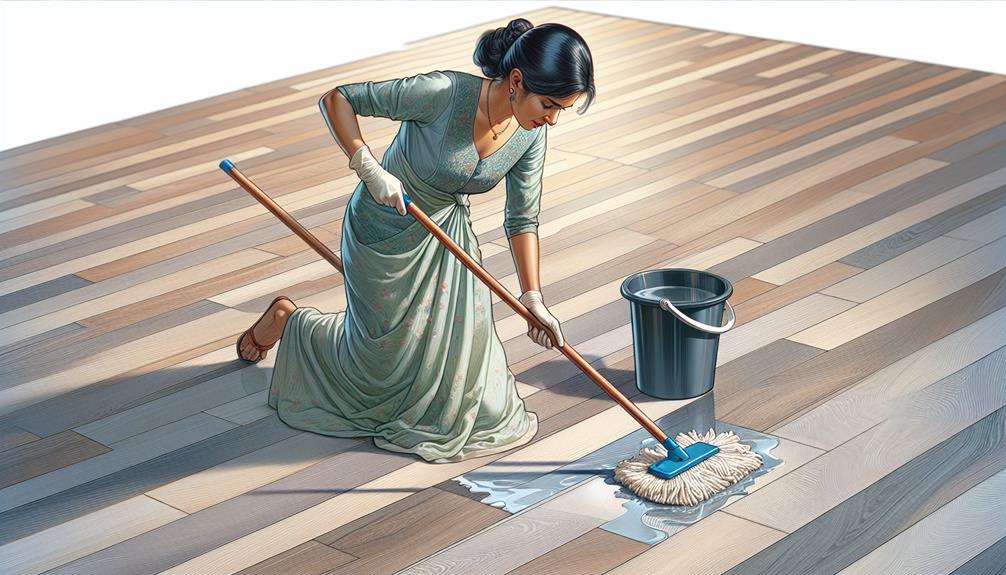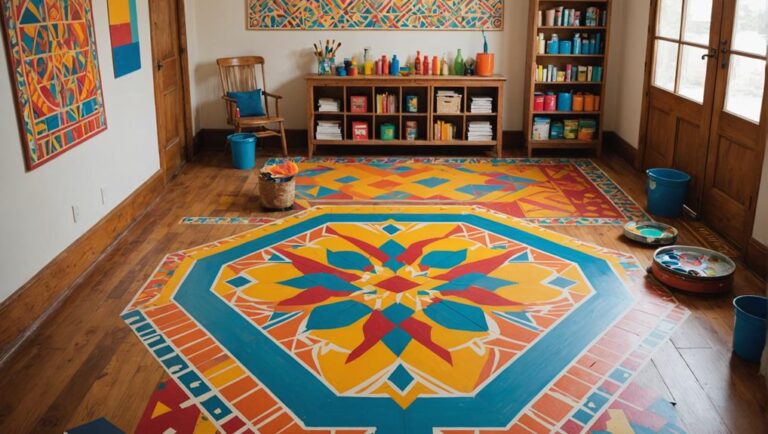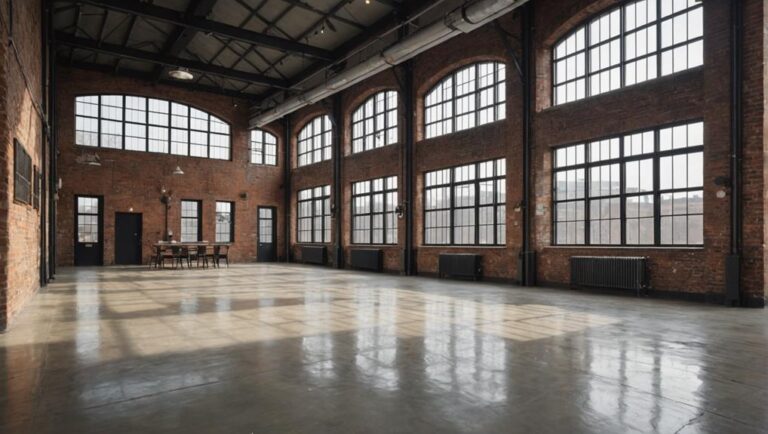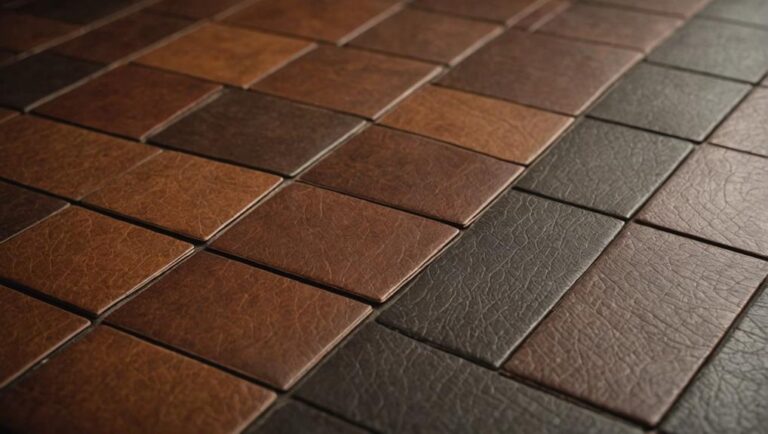To clean your LVP flooring effectively, start by sweeping and vacuuming regularly to prevent dirt buildup. Address stains promptly using mild detergent or baking soda. Opt for pH-neutral cleaners and avoid harsh chemicals that can damage your floors. Mop with a damp cloth, concentrating on high-traffic areas. Be cautious with steam cleaning and prevent scratches by using furniture pads. Protect floors from water exposure and implement a routine maintenance plan. These steps will help maintain the cleanliness and longevity of your LVP flooring. More tips and detailed solutions are available to enhance your floor care routine.
Regular Sweeping and Vacuuming
To keep your LVP flooring clean, regularly sweep or vacuum to remove dust and debris. This simple routine will maintain the beauty and longevity of your floors without much hassle. By sweeping or vacuuming frequently, you prevent dirt from accumulating and potentially causing scratches or damage. Plus, it gives your space an instant refresh, making it more inviting for you and your guests.
Sweeping or vacuuming also helps in preventing small particles from grinding into the floor when people walk over them. This proactive approach saves you time and effort in the long run. Imagine the freedom of knowing your floors are consistently clean without having to spend hours scrubbing or dealing with stubborn stains.
Incorporating regular sweeping or vacuuming into your cleaning routine allows you to enjoy your space without worrying about dirt buildup. It’s a small effort that goes a long way in maintaining the pristine look of your LVP flooring.
Spot Cleaning Stains Promptly
Address stains on your LVP flooring promptly to prevent them from setting and becoming more difficult to remove. When you notice a spill or stain, grab a clean cloth or paper towel and blot the area gently to soak up as much of the liquid as possible. Avoid rubbing the stain, as this can cause it to spread and set into the flooring.
Once you’ve absorbed the excess liquid, dampen a cloth with water and a mild detergent to gently wipe the stained area. Remember to dry the spot thoroughly with a clean towel afterwards. For tougher stains like grease or markers, you can use a mixture of baking soda and water to create a paste, apply it to the stain, let it sit for a few minutes, and then wipe it away.
Using a Ph-Neutral Cleaner
When cleaning your LVP flooring, opt for a pH-neutral cleaner to maintain its quality and appearance effectively. pH-neutral cleaners are gentle yet powerful, ensuring your floors are clean without causing any damage. These cleaners are safe for your LVP flooring and don’t leave behind any residue or streaks. They’re specifically formulated to protect the integrity of your flooring while effectively removing dirt, grime, and spills.
To use a pH-neutral cleaner, simply dilute it according to the instructions on the packaging. Then, mop the solution onto the floor, ensuring even coverage. Use a damp mop to wipe away the cleaner, and then dry the floor thoroughly to prevent any water damage.
Avoid Harsh Chemicals
Opt for gentle cleaning solutions instead of harsh chemicals when maintaining your LVP flooring to preserve its quality and appearance effectively. While harsh chemicals may promise a quick fix, they can actually damage the protective layers of your flooring, leading to a shorter lifespan and a dull appearance. By choosing milder alternatives, you not only protect your floors but also create a safer environment for your household.
To help you make informed decisions, here are some common harsh chemicals to avoid when cleaning your LVP flooring:
| Harsh Chemical | Potential Damage | Safe Alternative |
|---|---|---|
| Bleach | Fading and discolouration | White vinegar |
| Ammonia | Dulling and streaking | Baking soda |
| Abrasive Cleaners | Scratches and wear | Mild dish soap |
| Citrus Cleaners | Degradation of finish | Water and soap |
Mopping With a Damp Cloth
To effectively clean your LVP flooring, consider using a damp cloth for mopping instead of soaking it excessively. Grab a clean cloth, dampen it with water or a mild cleaner, and wring out any excess liquid. Lightly mop the LVP flooring in a back-and-forth motion, focusing on high-traffic areas or spots that need a little extra attention. Remember, less moisture is key when mopping LVP floors to prevent any water damage or warping.
Using a damp cloth for mopping offers a gentle yet effective way to keep your LVP flooring looking its best without the need for harsh chemicals. Plus, it gives you the freedom to control the amount of moisture applied, ensuring a safe and efficient cleaning process. By following this method, you can maintain the beauty and longevity of your LVP flooring while enjoying a clean and fresh environment in your home.
Steam Cleaning With Caution
Consider exercising caution when using steam cleaning on your LVP flooring to avoid potential damage. While steam cleaning can be an effective method for deep cleaning various surfaces, including some types of flooring, it may not be the optimal choice for LVP.
The intense heat and moisture from steam cleaners can seep into the seams of the flooring, causing the adhesive to weaken and potentially leading to warping or separation of the planks. Additionally, excessive moisture can damage the protective wear layer of the LVP, compromising its durability and longevity.
If you still prefer to use a steam cleaner, make sure to keep the steam at a low intensity, avoid prolonged exposure to any one area, and immediately dry the floor thoroughly after cleaning. Adhering to the manufacturer’s guidelines for cleaning and maintenance is crucial to prevent voiding any warranties.
Ultimately, opting for gentler cleaning methods like damp mopping or using manufacturer-recommended cleaning products may be safer choices for preserving the quality of your LVP flooring.
Prevention of Scratches and Scuffs
To prevent scratches and scuffs on your LVP flooring, utilize furniture pads under heavy items and regularly sweep or vacuum debris that could cause damage. This simple practice will help maintain the pristine look of your floors and extend their lifespan.
Here are some additional tips to safeguard your LVP flooring:
- Avoid dragging heavy furniture: Lift and place heavy items instead of dragging them across the floor.
- Use doormats: Place doormats at entrances to trap dirt and prevent it from being tracked onto your floors.
- Trim pet’s nails: Keep your pet’s nails trimmed to prevent scratches from their claws.
- Use soft-bristled brooms: Opt for soft-bristled brooms when sweeping to avoid scratching the surface.
- Apply felt protectors: Attach felt protectors to the bottom of furniture legs to prevent direct contact with the flooring.
Protecting Floors From Furniture
To prevent damage to your LVP flooring from furniture, make sure you use appropriate protective pads or covers on the bottom of furniture legs. This simple step can go a long way in safeguarding your floors from scratches and dents caused by moving or shifting furniture. Here’s a quick guide to help you choose the right protective pads for different types of furniture:
| Furniture Type | Recommended Protective Pads |
|---|---|
| Wooden Chairs | Felt pads or rubber caps |
| Metal Furniture | Rubber or plastic caps |
| Sofas and Tables | Heavy-duty felt pads |
| Furniture with Wheels | Soft rubber or felt casters |
| Heavy Furniture | Wide rubber or plastic pads |
Being Mindful of Water Exposure
When cleaning LVP flooring, it’s important to be mindful of water exposure to prevent any damage. Excessive water can seep into the seams and edges of the flooring, causing it to warp or swell. Here are some tips to help you clean your LVP floors while being cautious of water exposure:
- Use a Damp Mop: Instead of saturating your mop in water, wring it out well to guarantee it’s just damp enough to clean the floors effectively without leaving excess water behind.
- Avoid Standing Water: Quickly wipe up any spills or excess water to prevent it from sitting on the floor for too long.
- Use Recommended Cleaning Solutions: Stick to cleaning solutions that are specifically designed for LVP flooring to prevent any potential damage from harsh chemicals.
- Dry Thoroughly: After mopping, go over the floors with a dry microfiber cloth to ensure all moisture is removed.
- Limit Water Usage: Only use as much water as necessary when cleaning to reduce the risk of water damage.
Implementing a Routine Maintenance Plan
Establishing a regular maintenance schedule is crucial to preserving the longevity and appearance of your LVP flooring. By implementing a routine maintenance plan, you can make certain that your floors stay looking pristine and last for years to come.
Start by incorporating simple daily habits like sweeping or vacuuming to eliminate dirt and debris that can scratch the surface. For a deeper clean, mop with a manufacturer-approved cleaner on a weekly basis. Pay attention to high-traffic areas and clean up spills promptly to prevent staining or damage.
To maintain the beauty of your LVP flooring, consider using furniture pads to prevent scratches and dents, and placing doormats at entryways to minimize the amount of dirt brought in. Regularly trim your pets’ nails to avoid scratches, and be cautious when wearing high heels on the floors.
Frequently Asked Questions
Can I Use a Steam Mop on LVP Flooring?
You should not use a steam mop on LVP flooring. The high temperatures and moisture can damage the material. Stick to using a damp mop or a pH-neutral cleaner for safe and effective cleaning.
Is It Safe to Use Vinegar to Clean LVP Flooring?
Yes, it’s safe to use vinegar to clean LVP flooring. Mix vinegar with water for an effective cleaning solution. Avoid harsh chemicals that can damage the flooring. Vinegar is a natural and safe option for maintaining your LVP floors.
How Do I Remove Tough Stains Like Oil or Paint From LVP Flooring?
To remove tough stains like oil or paint from LVP flooring, grab a damp cloth and gently scrub the spot. Add a bit of dish soap if needed. Avoid harsh chemicals that could damage the floor.
Can I Use a Scrub Brush or Abrasive Pad to Clean LVP Flooring?
Sure, you can use a scrub brush or abrasive pad to clean LVP flooring. It’s the perfect way to show your floors who’s boss. Just remember, gentle strokes are key to keeping them shining like new!
How Do I Prevent Fading or Discoloration on LVP Flooring From Sunlight Exposure?
To prevent fading or discoloration on LVP flooring from sunlight exposure, keep blinds or curtains closed during peak sunlight hours. Consider using UV-protective window films or applying a protective coating to the floors.




